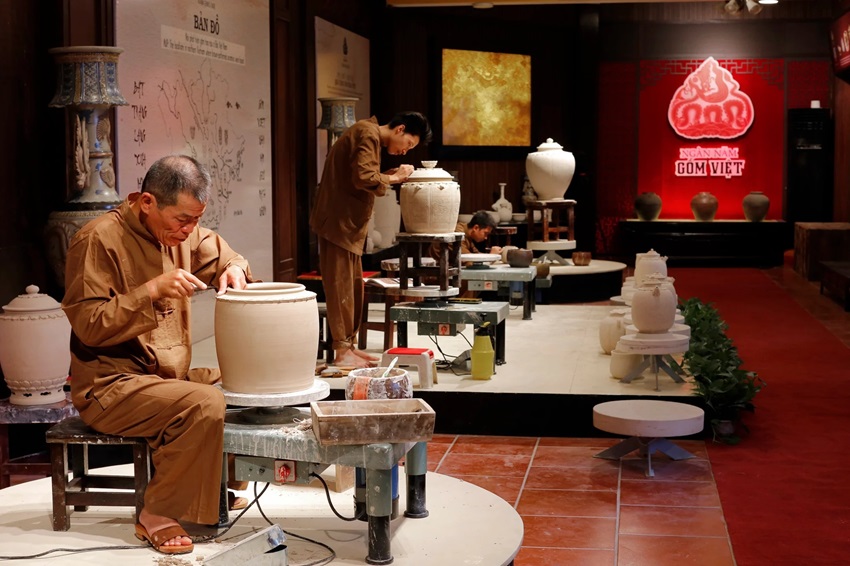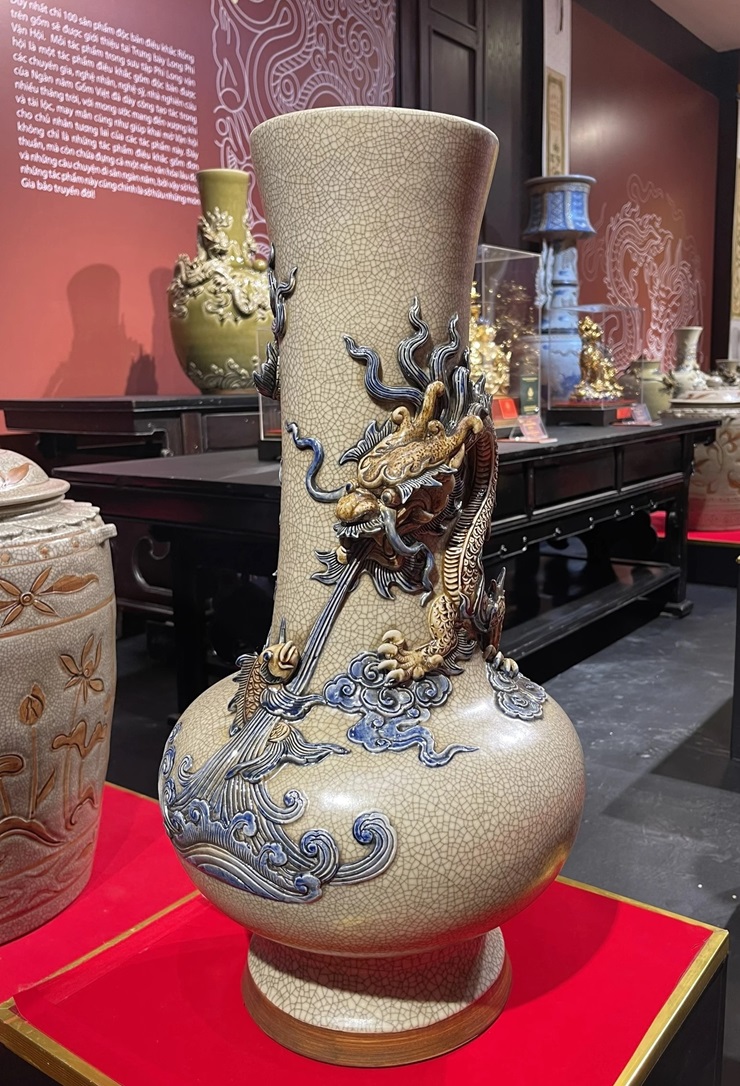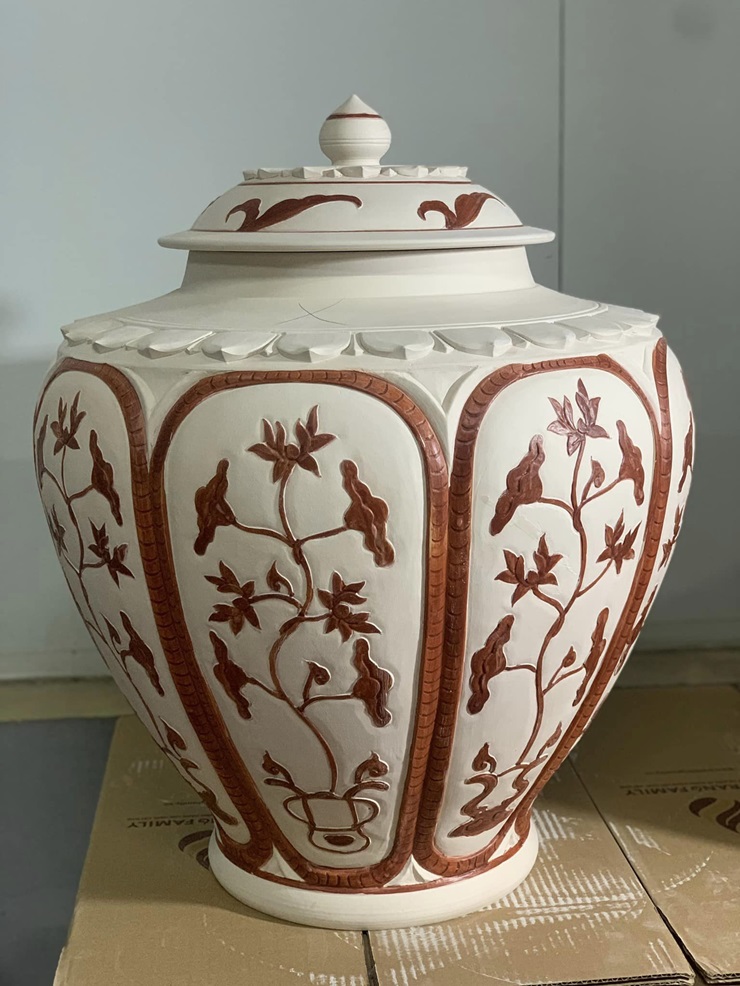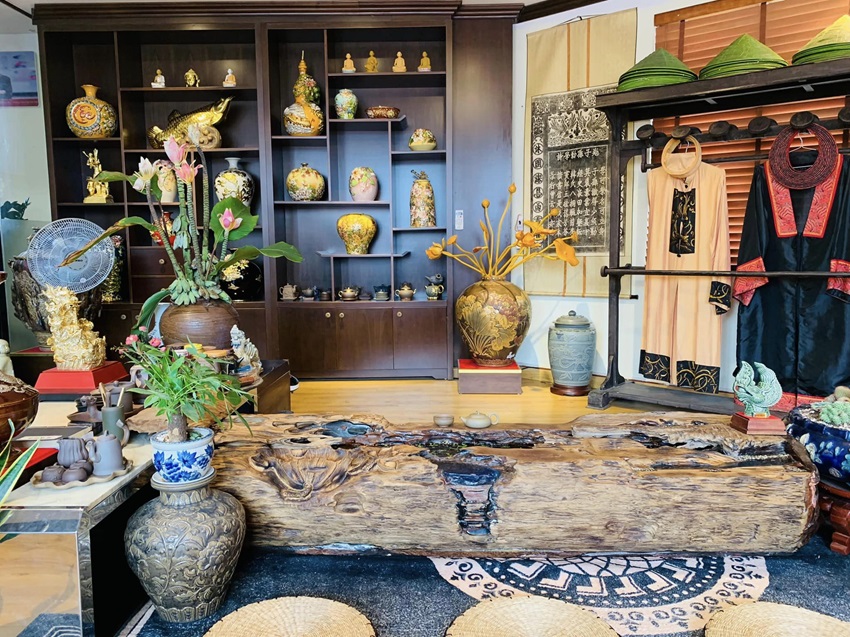Restoring the images of Vietnamese dragons on Bat Trang ceramics
A collection of 100 sculptures and vases with unique images of Vietnamese dragons was recently unveiled at the Vietnam Ceramics Center, Bat Trang Ceramic Village in Hanoi.
Dragon patterns through 1,000 years of history under the Vietnamese dynasties of Ly (1010-1225), Tran (1226-1400), Le (1428-1788) and Nguyen (1802-1945) have been depicted on a ceramic collection called "Long Phi Van Hoi" or "New Opportunity for the Flying Dragon".
This is the latest series of elite handicrafts created by artisans from Bat Trang pottery village to celebrate the upcoming Lunar New Year, the Year of the Dragon in 2024.
| Talented ceramicists from the Vietnam Ceramics Center, Bat Trang Ceramic Village in Gia Lam District, Hanoi. Photo courtesy of Vietnam Ceramics Center |
Cultural gift products of national significance
The massive ceramic collection of 100 products has been unveiled by a newly opened center for showcasing Bat Trang pottery products - the Vietnam Ceramics Center on the outskirts of Hanoi.
According to Dr. Nguyen Truong Giang of the Institute of Imperial Citadel Studies, over the past ten years, experts and artisans have diligently researched, restored and revived dragon patterns in Vietnam's history and depicted them on ceramic works that have been introduced to the public.
"These ceramic works all have a pure Vietnamese identity, evoking a golden memory of the Dai Viet civilization in the past. Each of the lines and details on the dragon are meticulously and delicately painted, demonstrating the precision and skill of Bat Trang potters," he said.
In fact, the ceramics on display at the ceramics center are all traditional utensils made by the Bat Trang Pottery Village, including the vases, jars and water containers... but larger than normal in size and used only as home decorations. There is also a unique gift collection of 100 elaborate ceramic dragon statues from the Ly, Tran, Le, and Nguyen dynasties.
According to Nguyen Trung Thanh, general director of the Vietnam Ceramics Center, it takes 30 days to complete a ceramic work, with dozens of complicated steps performed by various skilled ceramic artists.
| A ceramic piece from the Long Phi Van Hoi collection. Photo: Vietnam Ceramics Center |
"First, one craftsman will be responsible for shaping the vase. Then, another one will paint the dragon on it. Finally, the following stages of ceramic glazing and firing are handled by veteran potters," he said.
"Normally, the vase forming part is done by veteran artisans, while the painting part is the work of younger ceramicists who are well trained by art schools," he added.
He also hopes that these newly created sophisticated ceramic works will become meaningful gifts bearing the mark of Hanoi for distinguished guests at home and abroad on important occasions.
A pottery house for everyone
Thanh wishes that this will be a "common home" for everyone, where ceramic lovers, artisans, researchers, and especially collectors of ceramics and handicrafts can gather and discuss this traditional Vietnamese craft.
"Unique ceramic products or one-of-a-kind ceramic collections can be created here by Bat Trang ceramic village artisans and visitors," said Thanh, one of the founders of Vietnam Ceramics Center.
| A product of Bat Trang brown-glazed ceramic line. |
"Pottery not only has heirloom value that is passed down from generation to generation, but it also helps convey Vietnamese cultural messages, connecting the past with the present and the future," he said.
Artisans from the Vietnam Ceramic Center are now conducting some research to restore the famous Bat Trang brown-glazed ceramics. This pure Vietnamese ceramic line once flourished under the Ly-Tran dynasties from the 11th to 13th centuries.
They also wish to display ceramic products in contemporary exhibition spaces to bring new vitality to the traditional ceramic line and, at the same time, pass it on forever to future generations.
Located in a spacious space at No. 10, Pottery Market Street, Bat Trang Ceramics Village, Gia Lam District, Hanoi, the Vietnam Ceramics Center is divided into various thematic areas, including a ceramic display area; a courtyard, a creative space for ceramic artisans; ceramic demonstrations for tourists and pottery students; and the "Mother's Kitchen" room, which recreates a traditional Vietnamese kitchen, among others. This promises to be a new and exciting travel attraction for domestic and international travelers, helping to enrich Hanoi's tourism offer.
| The space for a tea ceremony at Vietnam Ceramics Center. |
Considered the cradle of ceramics in Vietnam, Bat Trang is a traditional craft village located about 13 kilometers to the southeast of central Hanoi. The village's fame for producing high-quality ceramics and pottery products dates back to the 14th century. Bat Trang ceramics are unique in their elegant and delicate beauty. The typical Bat Trang clay core is a mixture of Red River sand and alluvium. The glaze is fired at a relatively high temperature - from 1,250 to 1,320 degrees Celsius - to produce a deep color characteristic of ancient ceramics. The glaze is an ash made by burning rice husk, mixing it with mud and limestone powder in a certain proportion, and then finely grinding it. The potters must be meticulous in selecting the clay, kneading, shaping, and refining the enameled patterns for each product. Historically, households in Bat Trang used coal kilns, but gas kilns have become the norm thanks to industrialization and modernization, as well as to reduce environmental pollution. Promoting the handicraft village in parallel with environmental protection will bring sustainable development and increase consumer preference. . |













-1741244616.jpg?w=480&h=320&q=100)

